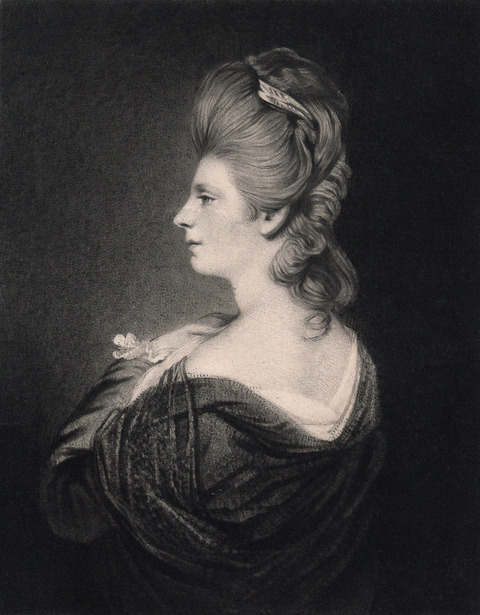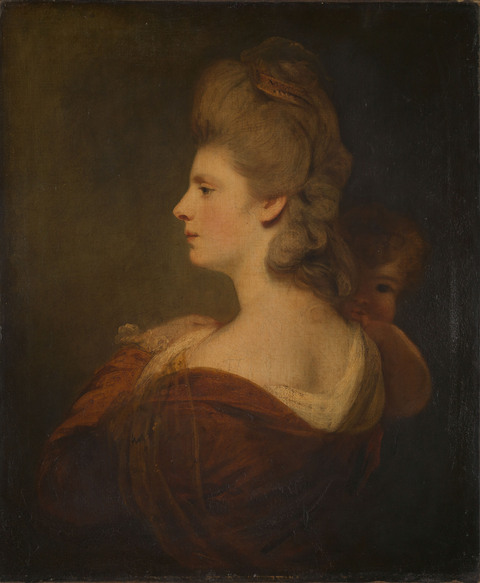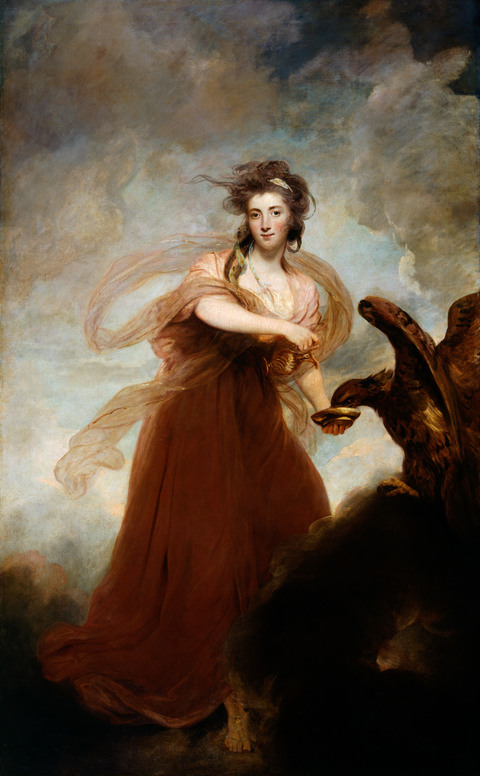Marks, Inscriptions, and Distinguishing Features
None
Entry
Although this attractive portrait is today attributed to a follower of Sir Joshua Reynolds, the identity of the sitter remains in question. An elegant lady in profile, in a russet gown, faces away from the viewer and looks over her left shoulder. This composition exists in two distinct versions and in multiple examples of each: in the Clowes type, the sitter is represented alone; the other type includes the figure of a child, clutched to the woman’s chest and peeking over her right shoulder. It is not clear which is the prime version of the composition, but scholars tend to agree that the original prototype by Reynolds has yet to be identified. Recent X-rays of the Clowes painting have, moreover, revealed the figure of the child, which had been painted out at some stage. As we are unable to X-ray all the versions depicting the woman alone, it is impossible to determine whether those have been altered in a similar fashion or were originally conceived as single-figure portraits.
The earliest correspondence in the Clowes archive relating to this portrait is a letter of expertise written by Dr. G. Mueller, in which he describes the work: “dignified in pose, fine in color, it is a desirable and attractive painting.” He attests: “In my opinion it is one of the fine examples from the brush of Sir Joshua." When the work was acquired from the books and manuscripts dealer Arthur Zinkin by George H.A. Clowes on the basis of that expertise, it was described as a portrait of “the Hon. Mrs. J.C. Fox,” an accidental inversion of the initials of Charles James Fox (1749–1806), the Whig politician.
Elizabeth Bridget Blane, Mrs. Armistead (1752–1842), wed Fox on 28 September 1795, having begun her life as a courtesan and actress. Prior to her marriage, she had been the mistress of a series of powerful and high-profile men, including the Prince of Wales (the future King George IV; 1762–1830). A notation in one of Reynolds’s appointment books for the week of 8 June 1772 lists a meeting with “Mrs. Armitstead [sic] at Mrs. Mitchell’s, Upper John Street, Soho Square,” although no portrait of Mrs. Armistead from this date is known. Elizabeth Mitchell was one of the most notorious madams of the era, and Mrs. Armistead was a courtesan in her brothel in Soho.
The identification of the sitter as Mrs. Fox is supported by an engraving by S.W. Reynolds (1773–1835), dated 1825 and captioned “Honble Mrs C J Fox.” This engraving may be after the Clowes version of the painting, as it does not include the child (fig. 1). A pencil notation in William Cotton III’s copy of Hodgson & Graves,
Engravings from the Work of Sir Joshua Reynolds, ii, 48, now in the Cottonian archives, Plymouth, reads “at Holland House."
This would seemingly support the identification of the sitter as well as the painting’s possible early provenance, although it does not explain why the Fox family should own a studio copy of a portrait rather than the prime version.
Figure 1: Samuel William Reynolds (British, 1773–1835), after Joshua Reynolds (English, 1723–1792), Honble Mrs. C.J. Fox, 1836, mezzotint engraving, 5-1/16 × 4-1/16 in. (image), 9-1/16 × 6-1/2 in. (plate), 15-15/16 × 11-1/32 in. (sheet). Hodgson & Graves, Engravings from the Work of Sir Joshua Reynolds (London, 1836).
Figure 1: Samuel William Reynolds (British, 1773–1835), after Joshua Reynolds (English, 1723–1792), Honble Mrs. C.J. Fox, 1836, mezzotint engraving, 5-1/16 × 4-1/16 in. (image), 9-1/16 × 6-1/2 in. (plate), 15-15/16 × 11-1/32 in. (sheet). Hodgson & Graves, Engravings from the Work of Sir Joshua Reynolds (London, 1836).
In his unpublished 1968 manuscript of the Clowes collection, Mark Roskill supports the identification of the portrait as Mrs. Fox. He dates it on stylistic grounds to the late 1770s. He further points out that a portrait of the same sitter by Reynolds, dated 1789, is recorded in the collection of the Hon. Stephen Fox Powys (M.676, fig. 1444), and that a portrait of Mrs. Fox as an old woman, shown frontally, was recorded in the collection of the Earl of Ilchester, Holland House.
Other names are attached to versions of this portrait, however. One in the Tate collection, which includes the infant (fig. 2), was called Mrs. Siddons by art historian Gustav Waagen in 1838 when he saw it in the collection of Sir Robert Peel (1788–1950).
Waagen admired the painting, which he considered to be “nobly and delicately treated, very tenderly modeled, in a clear, bright golden tone, with a pleasing harmony of effect."
An 1846 inventory of the Peel collection calls the painting
Lady and Child. The Tate accepted this title when the painting entered its collection, revising it in 1929 to
?Lady Gideon & Child.
The museum’s website gives the current title as
Mrs. Fox, with a date of about 1780.
Figure 2: Manner of Joshua Reynolds (English, 1723–1792), Mrs. Fox, about 1780, oil on canvas, 29-1/2 × 24-1/2 in. Tate, London, N00891. Photo © Tate.
Figure 2: Manner of Joshua Reynolds (English, 1723–1792), Mrs. Fox, about 1780, oil on canvas, 29-1/2 × 24-1/2 in. Tate, London, N00891. Photo © Tate.
The authors of the first catalogue raisonné of Reynolds’s oeuvre, Algernon Graves and William Vine Cronin, identify the subject of the portrait as
Mrs. Musters.
Born Sophia Catherine (1758–1819), daughter of James Modyford Heywood, at Maristow House, Devon, and his wife Catherine, daughter of Major Chiverton Hartopp of Welby, Leicestershire, she married John Musters (1753–1827), of Colwick Hall, near Nottingham, on 29 or 30 July 1776. Mr. and Mrs. Musters both appear in the Reynolds account books, Mrs. Musters on several occasions, beginning in 1777. Six portraits of Mrs. Musters are recorded by Graves and Cronin, and at least three are securely attributed (plus two studio versions) in the recently published catalogue raisonné by David Mannings and Martin Postle, not including the possible identification of the
Lady and Child composition (fig. 3).
Figure 3: Joshua Reynolds (English, 1723–1792), Mrs. Musters as Hebe, 1782, oil on canvas, 94-1/64 × 57-1/64 in. English Heritage, Kenwood House, London, UK, Iveagh Bequest, 1929, PLB_J910498. Photo © Historic England Archive.
Figure 3: Joshua Reynolds (English, 1723–1792), Mrs. Musters as Hebe, 1782, oil on canvas, 94-1/64 × 57-1/64 in. English Heritage, Kenwood House, London, UK, Iveagh Bequest, 1929, PLB_J910498. Photo © Historic England Archive.
According to Graves and Cronin, the Clowes portrait type with the addition of the child exists in two versions. The first of these is the ex-Peel (now Tate) version, and there was evidently a “duplicate” in the collection at Colwick Hall. Graves and Cronin state that this duplicate remained with Mrs. Musters at Granville Mansions, Granville Place, until at least 1872; it was then auctioned at Christie’s on 28 July 1888, lot 6, where it was sold for £9 19s 6d to Hodgkins.
The existence of these two versions is supported by the annotation on the British Museum’s copy of the S.W. Reynolds engraving: “A similar portrait to this (but carrying a child) at Colwick Hall, Notts., is called Mrs. Musters; a duplicate of that is in the National Gallery [ex-Peel collection, now Tate].” The child was presumably Mrs. Musters’s son John, then about two years old.
A version of the portrait at Madresfield Court is called Lady Deerhurst, which Mannings believes may be correct. Catherine (1757–1779), fourth daughter of Robert Henley, 1st Earl of Northington, eloped on 18 March 1777 with George William, Viscount Deerhurst, later 7th Earl of Coventry (1758–1831); she later died in childbirth.
Among the additional recorded versions are a picture at Brympton d’Evercy, Somerset, which was called “an old studio (?) copy” by E.K. Waterhouse. A version sold at Sotheby’s in January 1989 was identified as a portrait of the actress Sarah Siddons (1755–1831). A miniature version by Samuel Shelley (about 1750–1808), dated 1783, was sold at Christie’s in July 1985.
Mannings and Postle propose that the version with the child is the primary composition, but Martin Myrone of the Tate disagrees. He finds its inclusion awkward and unconvincing. Given, however, that the X-ray of the Clowes portrait reveals that the figure of the child had been present before being overpainted, it may be that the first composition included a child, too. Regarding the attribution, all known versions are now generally considered copies after a lost original by Reynolds. The Tate picture is catalogued as “Manner of Sir Joshua Reynolds,” while Roskill classified the Clowes picture as “School of Reynolds.” Mannings, who has seen the X-ray of the Clowes picture, maintains his initial position, writing: “I have looked in my files but unfortunately I don’t have anything to add to what I said in my entry in the catalogue."
Author
Molly Dorkin Taylor
Provenance
Forthcoming
Exhibitions
Indiana University Art Museum, Bloomington, 1963, Northern European Painting: The Clowes Fund Collection, no. 49;
Franklin College, Franklin, IN, 1965, Italian, Flemish, and English Painting, 1500–1800: From the Clowes Fund Collection, no. 17;
Indianapolis Museum of Art at Newfields, 2019, Life and Legacy: Portraits from the Clowes Collection as Portrait of a Woman, presumed to be Mrs. Charles James Fox.
References
Algernon Graves and William Vine Cronin, A History of the Works of Sir Joshua Reynolds, P.R.A. (London: Henry Graves and Co., 1899–1901), 3:685, as Mrs. Musters;
A. Ian Fraser, A Catalogue of the Clowes Collection (Indianapolis: Indianapolis Museum of Art, 1973), 94–95;
David Mannings and Martin Postle, Sir Joshua Reynolds: A Complete Catalogue of His Paintings (New Haven and London: Yale University Press, 2000), 1:498, no. 2006, under “Unidentified Sitters”; 2: fig. 1297.
Notes



